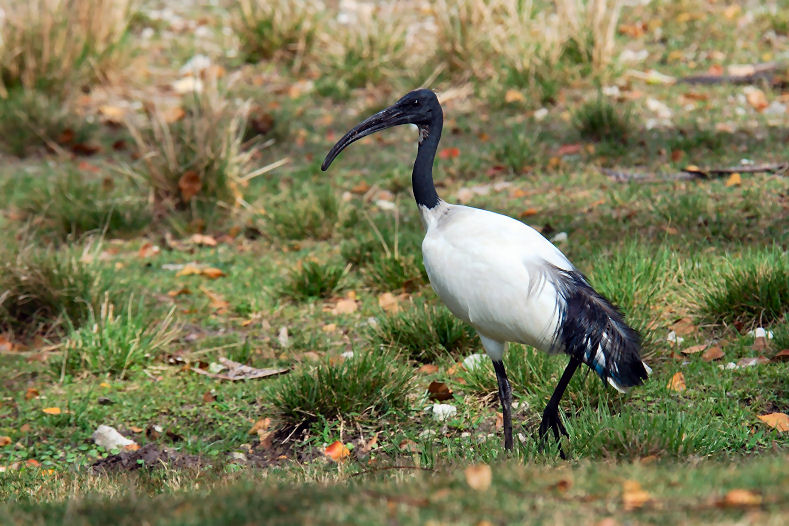- Sacred Ibis
Taxobox
name = Sacred Ibis
status = LC | status_system = IUCN3.1

image_width = 200px
regnum =Animal ia
phylum = Chordata
classis = Aves
ordo =Ciconiiformes
familia =Threskiornithidae
genus = "Threskiornis "
species = "T. aethiopicus"
binomial = "Threskiornis aethiopicus"
binomial_authority = (Latham, 1790)The Sacred Ibis ("Threskiornis aethiopicus") is a species of wading
bird of theibis family, Threskiornithidae, which breeds in sub-SaharanAfrica , SEIraq and formerly inEgypt , where it was venerated and often mummified as a symbol of the godThoth . It has also been introduced intoFrance ,Italy ,Spain , and theUnited States (S.Florida).The bird nests in tree colonies, often with other large wading birds such as
heron s. It builds a stick nest often in abaobab and lays 2-3 eggs.The Sacred Ibis occurs in marshy wetlands and mud flats, both inland and on the coast. It will also visit cultivation and rubbish dumps. It feeds on various
fish ,frog s and other water creatures, as well asinsect s. An adult individual is 68 cm long with all-white bodyplumage apart from dark plumes on the rump. The bald head and neck, thick curved bill and legs are black. The white wings show a black rear border in flight. Sexes are similar, but juveniles have dirty white plumage, a smaller bill and some feathering on the neck.This bird is usually silent, but occasionally makes some croaking noises.
The introduced and rapidly growing populations in southern Europe are seen as a potential problem, since these large predators can devastate breeding colonies of species such as
tern s. They also compete successfully for nest sites with Cattle andLittle Egret s. The adaptable Ibises supplement their diet by feeding at rubbish tips, which helps them to survive the winter in these temperate regions.The Sacred Ibis is one of the species to which the "Agreement on the Conservation of African-Eurasian Migratory Waterbirds" (
AEWA ) applies.Evolution
Phylogeny
The Sacred Ibis, or Threskiornis Aethiopicusis is a large black and white coloured wading bird, belonging to the family Threskiornithidae. It is related closely to the Heron, also a wading bird, found in the family Ardeidae. The tree of life shows us that the Sacred Ibis and the Heron diverged from a common ancestor to form two separate species. The Sacred Ibis is also quite closely related to the Pelican (Pelecanidae family), and the Stork (Ciconiidae family), although their relation is more distant than that of the Sacred Ibis and Heron, as you have to look back further in time to find a commonly shared ancestor of these two species.
All bird species, including that of the Sacred Ibis have been found to have diverged from a species called the Maniraptor, a branch of bird-like dinosaur. This divergence is said to have happened during the Jurassic period of the Mesozoic Era. The tree of life shows that birds diverged from dinosaurs approximately 205 million years ago.
Homologous Features
The Sacred Ibis has a pentadactyl wing, meaning that it is composed of a proximal bone, two distal bones, and a series of carpels, metacarpals and phalanges. It uses this wing for flight. This basic bone structure is shared by a wide variety of different animals, including mammals such as monkeys, whales and horses. In the pentadactyl limbs of a horse, there is a great elongation of the third digit, bearing a hoof. This gives the legs support and allows the horse to run. Each of these animals has adapted a pentadactyl limb that will serve a particular function, in order to carry out its way of life. The pentadactyl limb is an example of a homologous feature, as the basic structure is the same in each different species, although each has been adapted for a particular way of life. This shows that the pentadactyl limb began in a common ancestor of all animals who contain it, and it has been passed along for species to species, as they diverge.
Analogous Features
The Sacred Ibis is a wadding bird, and has webbed feet that allow it to paddle in its sometimes-watery environment. When the Ibis pushes its foot back against the water, the flaps of skin in between its toes open, providing it with a larger surface area to move through the water more efficiently. As it draws its foot forward these flaps close to allow an easy forward movement. The Platypus is a semi-aquatic mammal that also has webbed feet, which it uses for swimming. Although both of these creatures have webbed feet, which they use for swimming, the structure of webbing is quite different. The platypus is able to tuck its webbing under the palm of its foot, so that its claws remain exposed for land functions, such as burrowing. The Sacred Ibis and the Platypus have each evolved webbed feet independently of each other, as they do not share a common ancestor with this trait. They have both evolved webbing between their feet, in order to assist them in carrying out common tasks, such as swimming. The webbed feet of the Sacred Ibis and the Platypus are analogous, as they correspond in function, but have not evolved from corresponding organs.
Sacred Ibis in myth and legend
Venerated and often mummified by Ancient Egyptians as a symbol of the god
Thoth , the Ibis was according toHerodotus andPliny the Elder also invoked against incursions of serpents. It was also said that the flies that brought pestilence died immediately upon propitiatory sacrifices of this bird (Pliny, "Natural History" Book X Chapter 41).References
* Database entry includes justification for why this species is of least concern
* Barlow, Wacher and Disley, "Birds of The Gambia". ISBN 1-873403-32-1External links
* [http://ibc.hbw.com/ibc/phtml/especie.phtml?idEspecie=362 Sacred Ibis videos] on the Internet Bird Collection
Wikimedia Foundation. 2010.
